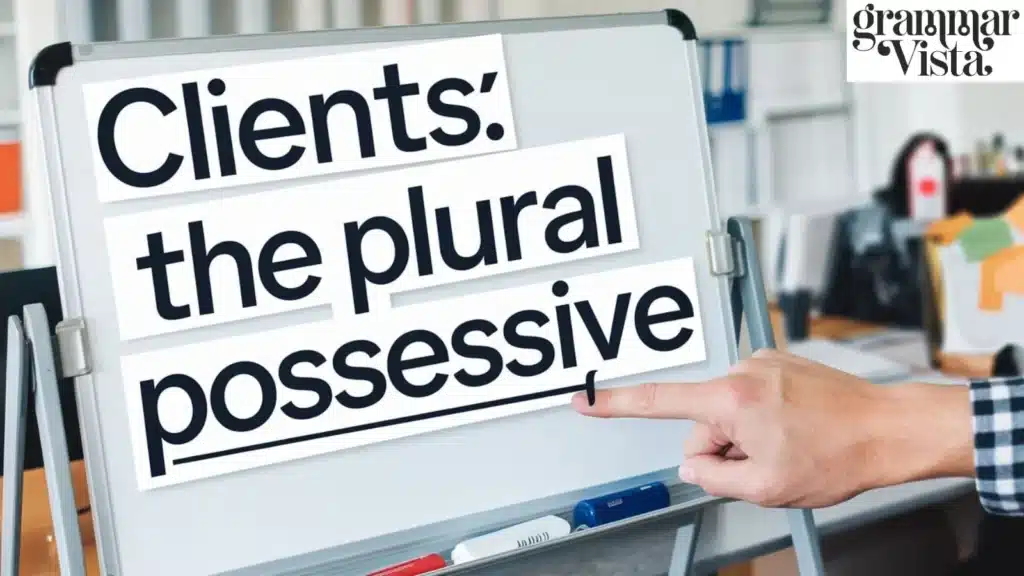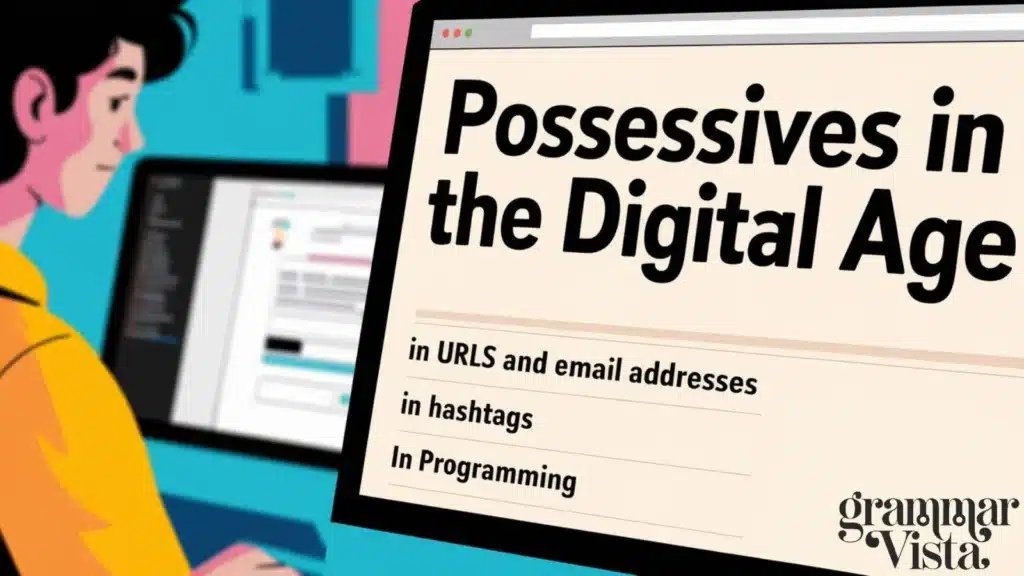Ever stumbled over whether to write “client’s,” “clients’,” or just “clients“? You’re not alone. This tiny apostrophe packs a punch, often leaving even seasoned writers scratching their heads. Let’s unravel this grammatical mystery and master the art of possessives in our client communications.
So, if you are interested to know the exact difference among the words “Client’s or Clients’ or Clients“, continue scrolling and give it a complete read!
The Possessive Puzzle: Client’s, Clients’, or Clients?
Ever found yourself staring at a word, wondering if you should add an apostrophe? You’re not alone. The English language loves to keep us on our toes, especially when it comes to possessives. Today, we’re diving into a common conundrum: should it be client’s, clients’, or just plain clients? Buckle up, language lovers – we’re about to unravel this grammatical mystery!
The Basics: Singular, Plural, and Possessive Forms
Before we tackle our main question, let’s refresh our memory on some fundamental concepts.
Singular vs. Plural
A singular noun refers to one person, place, thing, or idea. For example:
- One client
- A single book
- An individual thought
A plural noun, on the other hand, refers to more than one:
- Multiple clients
- Several books
- Various thoughts
Enter the Possessive
The possessive form shows ownership or a relationship between things. In English, we often use an apostrophe to indicate possession. But here’s where it gets tricky – the placement of that apostrophe depends on whether the noun is singular or plural.
Client’s: The Singular Possessive

When we’re talking about something belonging to a single client, we use the singular possessive form: client’s.
How to Form It
To create the singular possessive, we simply add an apostrophe followed by the letter ‘s’ to the end of the singular noun.
Example sentences:
- The client’s feedback was invaluable.
- I need to review the client’s file before our meeting.
- The client’s satisfaction is our top priority.
In each of these cases, we’re referring to one client and something that belongs to or is associated with that individual client.
Clients’: The Plural Possessive

Now, what if we’re dealing with multiple clients who collectively own or are associated with something? That’s where the plural possessive comes into play: clients’.
How to Form It
For regular plural nouns that end in ‘s’ (like “clients”), we form the possessive by adding an apostrophe after the ‘s’.
Example sentences:
- The clients’ concerns were addressed in the meeting.
- We need to improve our clients’ experience with our service.
- The clients’ portfolios showed significant growth this quarter.
In these examples, we’re talking about something that belongs to or is associated with multiple clients.
Clients: The Standard Plural

Sometimes, you might just need the regular plural form without any possession involved. In this case, it’s simply “clients” – no apostrophe needed.
Example sentences:
- We have ten new clients this month.
- The office was buzzing with clients all day.
- How many clients does your firm typically handle?
Here, we’re just referring to multiple clients without indicating ownership or a specific relationship.
Read More about Business’ or Business’s?
Diving Deeper: Tricky Scenarios and Common Mistakes
Now that we’ve covered the basics, let’s explore some situations that might trip you up.
When the Singular Noun Ends in ‘S’
What happens when you have a singular noun that already ends in ‘s’? For example, let’s consider the name “Chris” or the word “boss”.
In these cases, you have two options:
- Add apostrophe + s: Chris’s, boss’s
- Add only an apostrophe: Chris’, boss’
Both forms are considered correct, but adding the extra ‘s’ is becoming more common and is often preferred for clarity.
Example sentences:
- Chris’s project was selected for the showcase. (or Chris’ project)
- The boss’s decision surprised everyone. (or boss’ decision)
Plural Nouns That Don’t End in ‘S’
Not all plural nouns end in ‘s’. Consider words like “children,” “people,” or “mice.” For these irregular plurals, we form the possessive by adding apostrophe + s, just like we do for singular nouns.
Example sentences:
- The children’s toys were scattered across the room.
- People’s opinions on the matter varied widely.
- The mice’s tiny footprints were visible in the dust.
Compound Nouns and Joint Possession

When dealing with compound nouns or joint possession, things can get a bit more complex.
Compound Nouns
For compound nouns, add the possessive ‘s to the end of the entire compound.
Example sentences:
- My brother-in-law’s car broke down yesterday.
- The editor-in-chief’s decision was final.
Joint Possession
When two or more nouns possess the same thing, add the possessive ‘s to the last noun only.
Example sentence:
- Tom and Jerry’s adventures have entertained generations.
But if the possession is separate, each noun gets the possessive form:
Example sentence:
- Tom’s and Jerry’s character designs have evolved over the years.
You might be interested in Luis’ or Luis’s?
Real-World Applications: “Client’s,” “Clients’,” and “Clients” in Context
Let’s explore how these different forms might appear in various professional scenarios.
In Business Communications
Client’s (Singular Possessive)
- “I’ve reviewed the client’s proposal and have some suggestions.”
- “The client’s logo needs to be more prominent in the design.”
- “We need to address the client’s concern about the project timeline.”
Clients’ (Plural Possessive)
- “The clients’ feedback has been overwhelmingly positive.”
- “We need to reassess our clients’ needs in light of recent market changes.”
- “The clients’ confidential information must be protected at all times.”
Clients (Standard Plural)
- “We’re expecting several new clients to sign contracts this week.”
- “How many clients attended the product launch event?”
- “Our firm specializes in helping small business clients.”
In Legal Documents
Client’s (Singular Possessive)
- “The client’s testimony was crucial to winning the case.”
- “We must protect our client’s interests at all costs.”
- “The client’s signature is required on page three of the contract.”
Clients’ (Plural Possessive)
- “Our clients’ rights are our top priority.”
- “The clients’ cases will be heard in order of filing date.”
- “We need to update our clients’ records in the database.”
Clients (Standard Plural)
- “The law firm represents high-profile clients in entertainment and sports.”
- “How many clients does each attorney typically manage?”
- “We’re currently not accepting new clients for this practice area.”
In Customer Service
Client’s (Singular Possessive)
- “I’ve escalated the client’s complaint to the manager.”
- “Can you check the client’s account status?”
- “The client’s satisfaction score improved after our follow-up call.”
Clients’ (Plural Possessive)
- “We need to improve our clients’ overall experience with our product.”
- “The clients’ feedback has led to several product improvements.”
- “Our clients’ privacy is protected by our strict data policies.”
Clients (Standard Plural)
- “How many clients called in with this issue today?”
- “We’re rolling out a new loyalty program for our long-term clients.”
- “Our clients range from small startups to Fortune 500 companies.”
Common Mistakes and How to Avoid Them
Even seasoned writers can stumble when it comes to possessives. Here are some common pitfalls and how to sidestep them:
Mistake #1: Confusing Its and It’s
This is one of the most common errors in English writing. Remember:
- Its is the possessive form (no apostrophe)
- It’s is a contraction of “it is” or “it has”
Example sentences:
- The company valued its clients. (possessive)
- It’s important to listen to client feedback. (contraction of “it is”)
Mistake #2: Unnecessary Apostrophes in Plurals
Some writers mistakenly add apostrophes when they’re simply trying to make a word plural.
Incorrect: The company has many client’s.
Correct: The company has many clients.
Mistake #3: Misplacing the Apostrophe in Plural Possessives
When dealing with regular plural nouns that already end in ‘s’, remember to place the apostrophe after the ‘s’.
Incorrect: The client’s’ complaints were addressed promptly.
Correct: The clients’ complaints were addressed promptly.
Mistake #4: Forgetting Possessives in Compound Constructions
When you have a compound construction, it’s easy to forget to make both parts possessive if they’re meant to be.
Incorrect: My brother and sister’s cars are in the shop.
Correct: My brother’s and sister’s cars are in the shop. (if they have separate cars)
Mistake #5: Overusing Possessives
Sometimes, writers use possessives when a simple noun or prepositional phrase would suffice.
Wordy: The client’s satisfaction is crucial to the company’s success.
Better: Client satisfaction is crucial to the company’s success.
The Evolution of Possessives in English
The use of possessives in English has a fascinating history. The apostrophe as we know it today didn’t always exist. In Old English, possession was indicated by endings added to nouns, similar to how some languages like German still do it.
The apostrophe started appearing in English writing in the 16th century, initially to indicate omitted letters in contractions. Its use for possessives came later, in the 17th century. Even then, it wasn’t consistently used as we use it today.
Interestingly, some language experts argue that the apostrophe is becoming less necessary in modern English. They point to examples like “teachers college” or “writers guild” where the first noun functions as an adjective rather than a true possessive.
However, for now, the apostrophe remains an important part of Standard English, helping us distinguish between plurals and possessives, and between singular and plural possessives.
Read More grammar lessons on GrammarVista
Possessives in the Digital Age

In our increasingly digital world, possessives present unique challenges:
In URLs and Email Addresses
Most web addresses and email systems don’t allow apostrophes. This has led to creative workarounds:
- clientsfeedback.com instead of client’sfeedback.com
- [email protected] instead of client’[email protected]
In Hashtags
Social media platforms like Twitter don’t recognize apostrophes in hashtags. This has influenced how we write:
- #ClientsFeedback instead of #Client’sFeedback
- #ClientsDay instead of #Client’sDay
In Programming
Many programming languages use apostrophes for specific functions, which can complicate the use of possessives in code or when naming variables:
- clients data instead of client’s data
- clients Array instead of client’s Array
These digital constraints are slowly shaping how we think about and use possessives, even in more traditional writing contexts.
Conclusion: Mastering the Art of Possessives
Understanding when to use “client’s,” “clients’,” or simply “clients” is more than just a grammatical exercise – it’s about clear communication. By mastering these forms, you’re ensuring your message is understood exactly as you intend it.
Remember:
- Client’s for something belonging to one client
- Clients’ for something belonging to multiple clients
- Clients when you’re simply referring to more than one client
As with many aspects of language, context is key. When in doubt, read your sentence aloud and consider what you’re trying to convey. With practice, choosing the correct form will become second nature.
Language is a living thing, constantly evolving. While the rules we’ve discussed here represent current standard usage, it’s always worth keeping an eye on how language is changing. Who knows? In a few decades, we might be writing about entirely new ways of showing possession!
Until then, may your apostrophes be placed wisely, your clients (or client’s, or clients’) be satisfied, and your writing be clear and effective. Happy writing!







